E-learning for healthcare is not only beneficial for students but also for established healthcare staff. It is a great way for healthcare specialists to stay on track, communicate with colleagues,, improve their professional knowledge, or even get a new official degree.
However, healthcare professionals worldwide often have very demanding schedules and lack time for training. How can they stay current with these changes? This is where electronic learning comes in: it is flexible, easy to understand, and applicable to individuals’ needs. E-learning is reshaping how healthcare professionals learn, collaborate, and adapt in a dynamic field. Now, let’s see why it is so critical.
Growing need for continuous learning in healthcare
The healthcare industry is experiencing record-breaking advancement, which leads health system leaders worldwide to make operational efficiency and productivity improvements their top priorities for 2025. Statista shows that online education will generate revenue of US$279.30 billion by 2029.
Life Sciences & Health Care shows that C-suite executives from different nations identify the operational effectiveness of e-learning in healthcare as the core organizational objective for the current year. However, due to healthcare's rapid development, health professionals must consciously maintain their expertise and skills to provide better patient care.
Due to medical advances and person-centered care, clinical complexity requires nursing staff to know the most recent clinical practices and treatment methods. Recent regulatory updates have expanded the oversight role of the U.S. Department of Health and Human Services, particularly around HIPAA compliance and patient safety protocols.
The rise of e-learning has emerged as a practical solution to educational needs, providing training resources that go beyond the limitations of conventional learning approaches. The importance of e-learning in healthcare education has grown steadily since MIT launched MOOCs in 2002, as education technology has evolved into cloud-based platforms and AI-powered training modules.
The development of e-learning over time
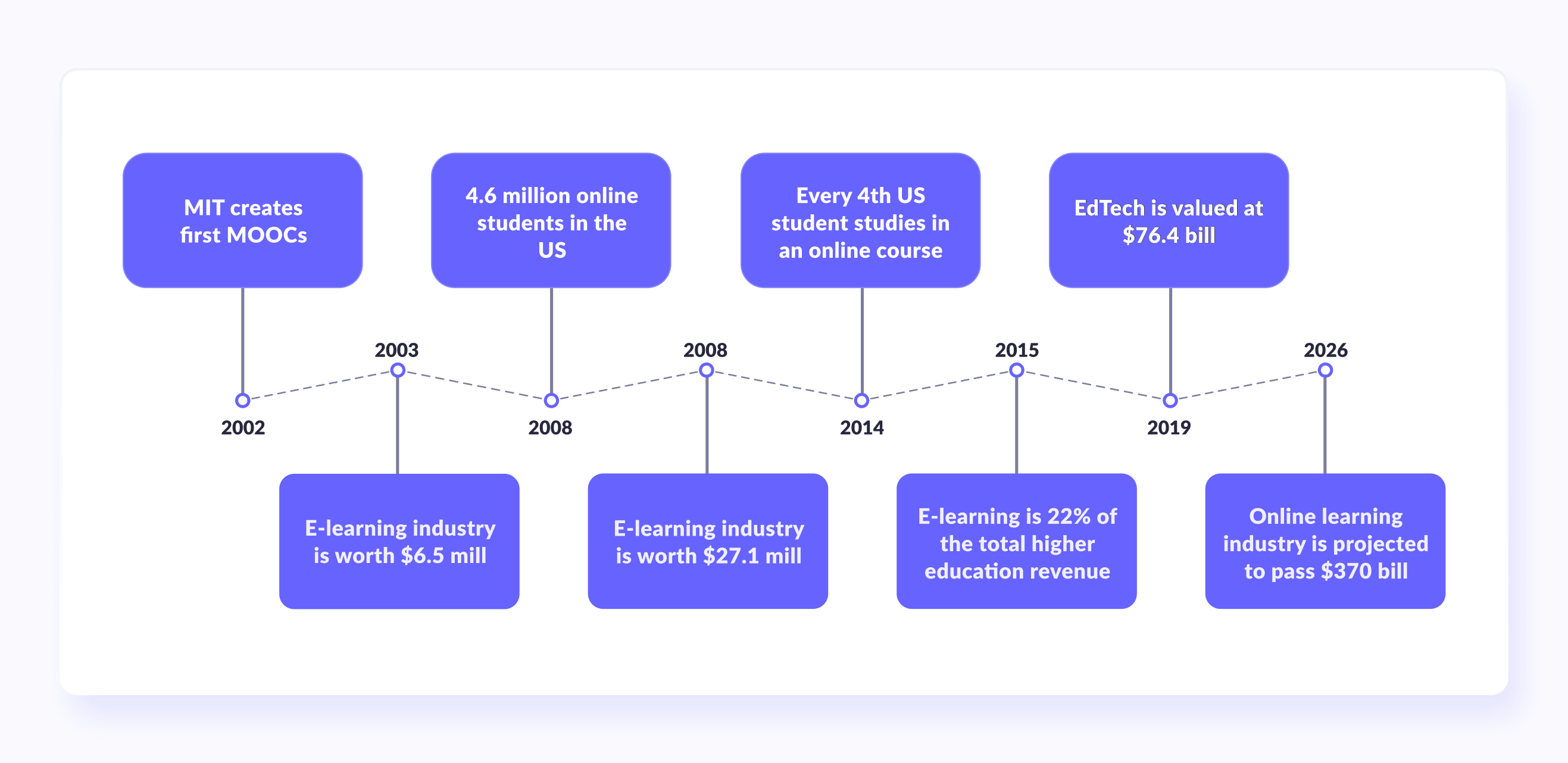
Healthcare e-learning development throughout time
The development of educational technologies is reshaping the healthcare environment by enabling tailored learning opportunities for medical students and healthcare professionals. These advancements offer personalized features that help learners engage more effectively and maximize their educational experience in the evolving healthcare industry.
Medical technology has changed, and using tools such as AI, AR, and deep learning now support both task execution and deeper understanding. The integration of continuous professional development (CPD) programs helps healthcare staff stay current across a wide range of organizations. Rapid access to knowledge became especially crucial during the pandemic, demonstrating healthcare needs efficient information delivery to support worldwide healthcare achievements.
As a result, the WHO Academy educational facility dedicated to bringing the lifelong learning revolution to the field, was developed. Located at a futuristic campus in Lyon, France, the Academy is scheduled to launch its first digital courses in May 2021. The Academy will be globally accessible to all healthcare professionals, offering personalized learning, and multilingual training that meets priority needs and takes traditional learning training methods to the next level.
The importance of e-learning for the healthcare industry
E-learning allows healthcare workers to decide when and how they want to learn. It also removes all boundaries, enabling people in remote areas to access high-quality medical education. They can also sign up for a webinar or topic-specific e-learning course and watch pre-recorded lectures when most convenient. For example:
Coursera offers various courses, such as a cancer course, that allow individuals to learn the latest skills, earn a degree, and reap various career benefits.
Modern Healthcare offers healthcare facilities many webinars that will help them stay up to date with the most recent events and developments of healthcare.
It’s also possible to use e-learning to attend universities and colleges and obtain a full-scale degree over time. For example, Best Medical Degrees allows you to find institutions to help you get a degree online in almost any field.
Busy healthcare professionals often spend their days caring for patients, leaving little time for traditional classroom-based training. That’s why e-learning is the most straightforward and efficient way for them to stay abreast of the latest developments in diagnoses, treatments, and medical best practices.
Overall, online education is more flexible, but what benefits does e-learning offer professionals compared to traditional classroom education?
10 benefits of e-learning for healthcare over traditional classroom learning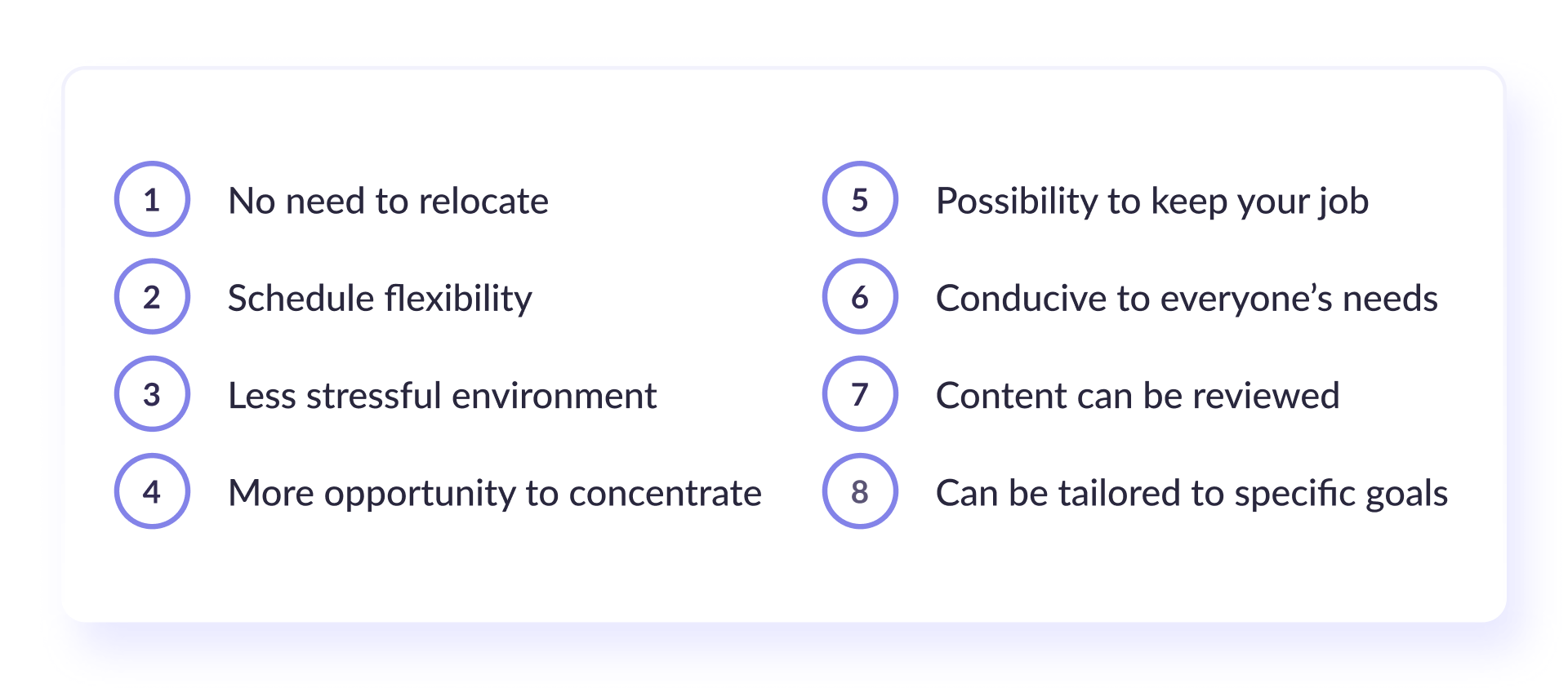
Based on our experience in online education and research in the field, we identified 10 key benefits of e-learning for the healthcare sector over conventional classroom-based learning.
1. Students don’t need to relocate
One of the biggest benefits of e-learning in healthcare, and in general, is that it allows people to enroll in any university, course, or webinar and attend it from the comfort of their homes. Individuals can enhance their skills and careers with an online college or graduate degree without moving to another city or country.
2. They can have a more flexible schedule
In general, e-learning allows students to study at their own pace and learn at a time of day and in the best place. When people control every part of their schedule, it is easier to maintain an active social and family life, and even work on learning.
3. A virtual classroom provides a less stressful learning environment
Reduced stress is the result of a flexible schedule. When people learn at their own pace, participate more comfortably, and don't have to travel or commute to college, their stress levels will stay low.
4. Students have more opportunities to concentrate and participate
People are productive at different times of the day. Thanks to e-learning, individuals can study when their brain is most engaged. Also, some people find it challenging to focus and participate in crowded classrooms. Digital learning can make it easier for students to concentrate and jump in with their questions and ideas.
5. E-learning makes it possible to keep your job
Sometimes, people want to stay in their company but climb the ladder. To do so, they have to improve their credentials. Attending college lectures is almost impossible when you have a full-time job. However, thanks to e-learning, there is no need to choose between school and work, as you can do both.


Thank you for Subscription!
6. E-learning adapts to different learning styles
E-learning can be tailored to suit various learner preferences and needs. This means that healthcare students can access multiple resources supporting long-term skill development, such as video lessons, audio lessons, webinars, textbooks, worksheets, etc.
7. Content can be reviewed an unlimited number of times
E-learning allows individuals to access the content as often as required, which is not the case with traditional classroom teaching. Healthcare is a broad field, and professionals can explore any topic they need, thanks to electronic learning.
8. E-learning can be tailored to healthcare education goals
Some of the tools allow the creation of various web-based training courses. Educators can design their lessons to address real-life scenarios. For example, students can practice "life or death" decision-making through case-based simulations and immediately see the ramifications of their decisions.
9. Online learning allows students to invest in themselves
Online learning enables healthcare specialists to stay updated with the latest developments and remain competent. It offers opportunities to gain new skills, expand medical knowledge, and earn certificates, ensuring success in the current and future career development.
10. E-learning improves the quality of living for patients
Providing high-quality care begins with being well-informed. The more you know, the better you are equipped to make decisions that improve patient outcomes. E-learning supports this by making critical knowledge and training more accessible and up-to-date.
Methods of e-learning for healthcare professionals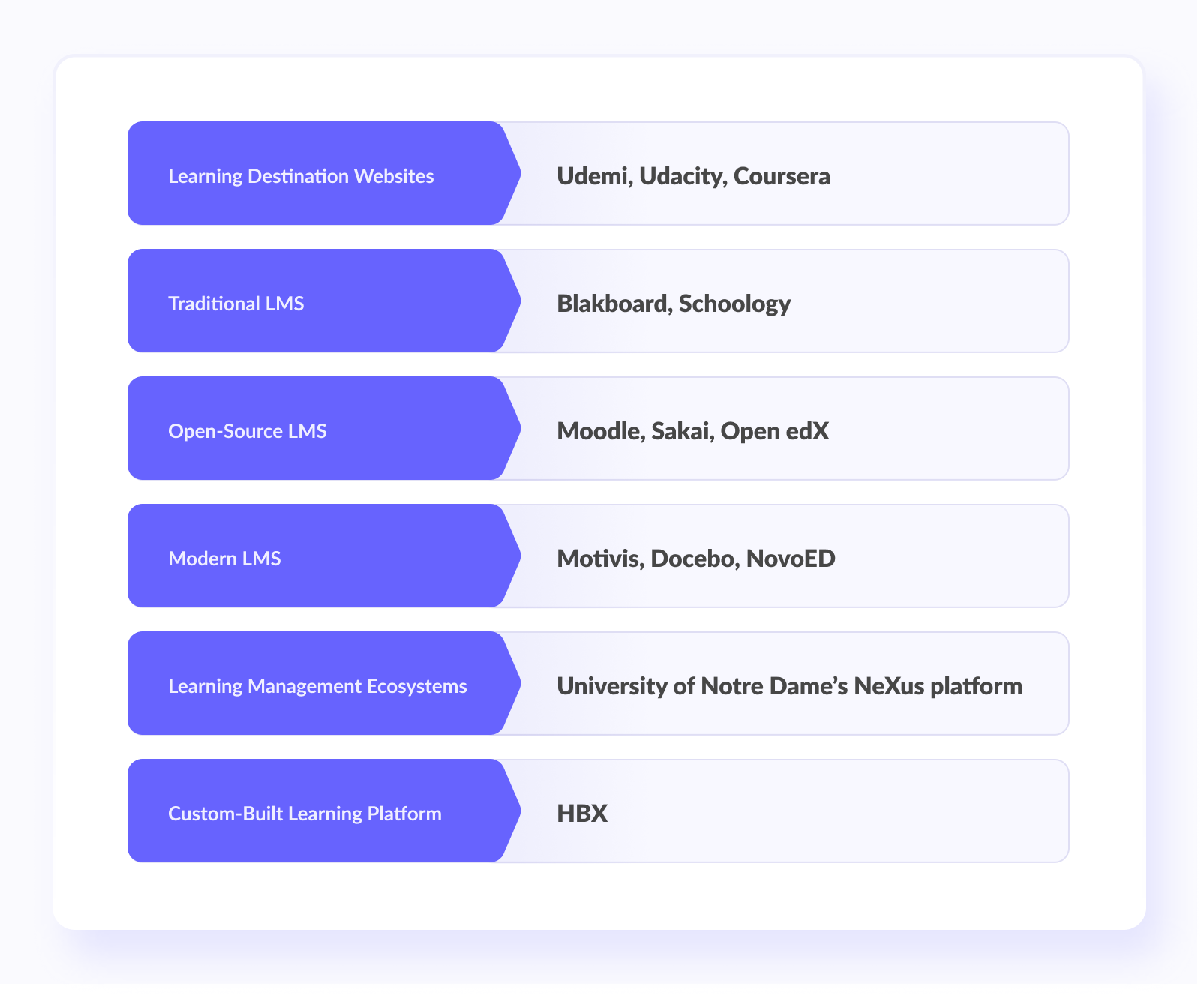
Although there are digital education methods, here are the most commonly used e-learning types among medical employees.
Learning destination websites
A learning destination site is a shared website that provides courses from several healthcare providers. These websites can be considered a storefront, similar to how Amazon acts as the front end for many stores.
The most common learning destination websites are Udemy, Udacity, Coursera, and edX.
Traditional LMS
A learning management system (LMS) allows individuals to develop and host an online course. The course designer can create course e-learning content, store it, manage learning profiles, report grades and progress, and perform other simple tasks characteristic of online courses.
There are more than 700 educational management systems providers, such as Blackboard and Schoology.
Open-source LMS
An open-source LMS has the same features and options as the traditional one. The only difference is that these programs are typically free of charge and can be customized.
Common open-source learning platforms are Moodle, Sakai, and Open edX.
Modern learning management solutions
Traditional LMSs often cause frustration as they are not up to date with the latest trends and technological innovations. Modern LMSs focus on the learner experience and specific learning approaches unsupported by traditional LMSs (for example, adaptive, personalized, collaborative, blended learning, etc.).
Numerous companies offer modern LMS, such as Motivis, Docebo, and EducateMe.
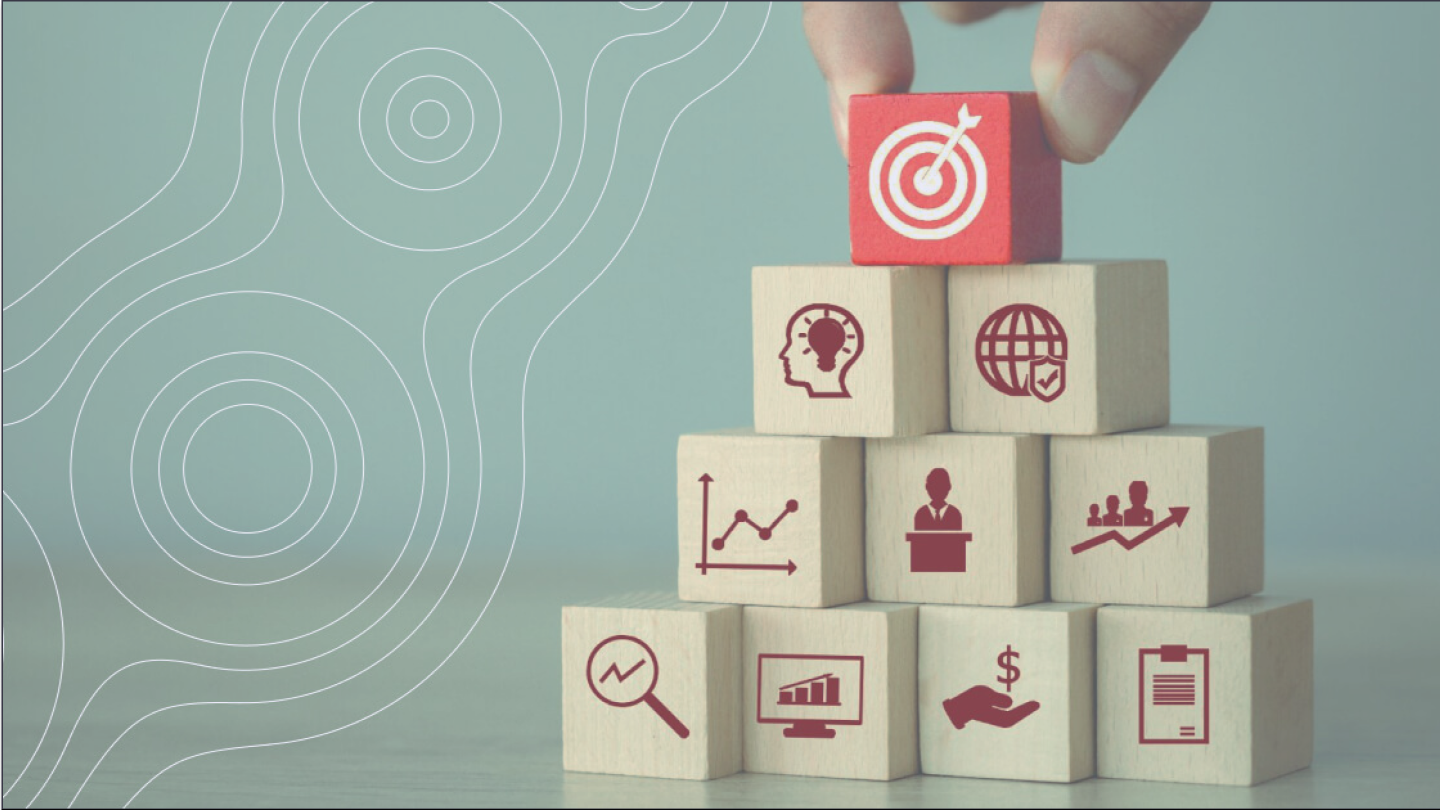
By the way...
How To Build LMS From Scratch
Get a fully personalized system and outstand competitors by empowering your employees with a custom LMS
Learn moreLearning management ecosystems
The education management ecosystem is another kind of online learning platform. In this model, businesses combine best-of-breed "point" solutions into a single framework.
Features include course authoring applications, evaluation tools, agile learning engines, e-commerce platforms, and learning content management systems, which are all combined and delivered to the learner as a single solution.
An excellent example of a learning management ecosystem is the University of Notre Dame's NeXus platform. It features Open edX at its core, but also integrates many other software tools.
Custom-built learning platform
Custom LMS development focuses on serving the business's needs, students' learning experience, and pedagogy. This solution is created from scratch, usually the most expensive, but it ensures complete control.
A great example of a custom-built learning platform is HBX, which was built specifically for Harvard Business School courses.
Examples of e-learning in healthcare
Native courses from universities and colleges. There are a few colleges that offer online healthcare courses, such as:
Third-party e-learning services. Several third-party services provide universities, colleges, or professionals in the industry with platforms to host their programs. The most popular ones include:

On the topic
10 Myths About Development of EdTech Projects
Do you know what are the main concerns about EdTech development and why there are not accurate?
Discover moreUse cases for healthcare e-learning
E-learning has become essential in areas like ongoing training for medical professionals and patient education. Below are a few fictional examples to illustrate how e-learning is applied in real-world healthcare scenarios.
1. Medical online training
An aspiring nurse, Sarah, wants to learn how to insert a catheter. However, her nursing program doesn't offer hands-on healthcare training for this skill. Sarah turns to an e-learning platform that offers a catheterization course. The training course provides step-by-step instructions and demonstrations that she can practice on a mannequin with virtual learning guidance until she feels confident in her abilities.
2. Patient education
Diabetic patient Mark has been in constant trouble for managing this condition. His doctor suggests that he enroll in an e-learning program to teach him how to monitor his blood sugar, administer insulin shots, and promote a healthy diet. Quizzes and interactive tools are included in the program to help Mark monitor his progress and make adjustments to his lifestyle.
3. Compliance training
Healthcare staff are under strict regulations and policies in hospitals and clinics. To ensure new employee Jane understands these rules, she enrolls in a compliance training program through an e-learning platform. The course includes interactive lessons on patient privacy, medical record keeping, and infection control. After completing the training, Jane feels confident in following the hospital's policies.
4. Continuing medical education (CME)
Dr. Smith has many years of practicing medicine and desires to keep up with the most recent research and best practices. She joins an e-learning program that offers continuing medical education courses focused on new treatment methods and technologies. The program allows her to study independently and earn CME credits on her own schedule.
5. Employee onboarding
Alex is a new healthcare member in the clinic and needs to learn about its history, culture, and policies. To support a smooth transition, the clinic provides an e-learning program that covers these topics and more. Alex can complete the program independently and review the material as needed. When he starts the role, he feels confident and well-prepared for his new workplace.
Our experience with e-learning for healthcare
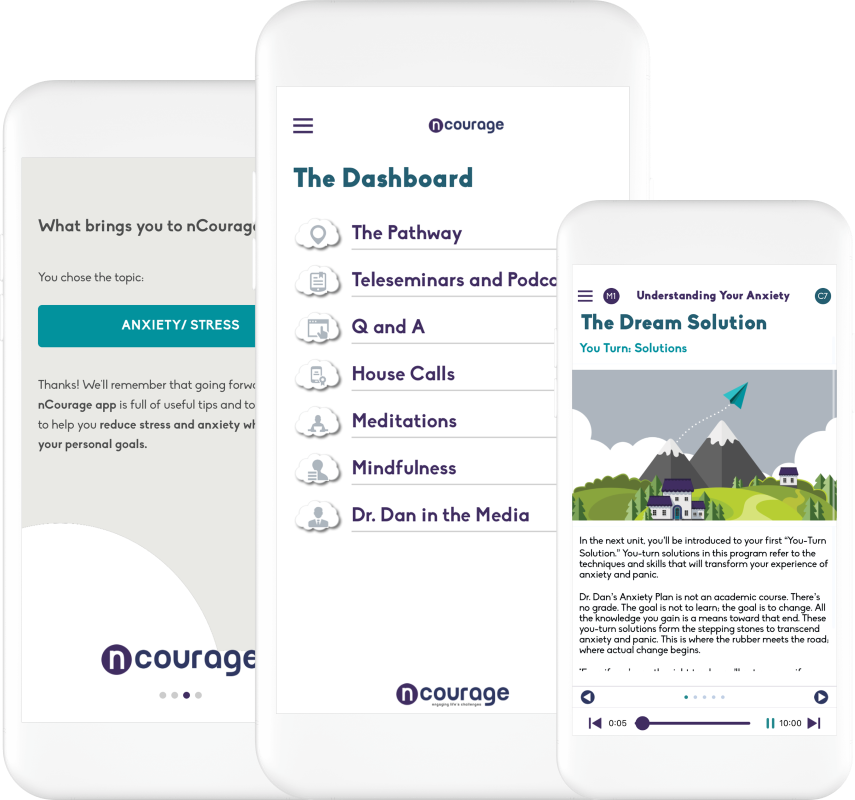
At Genuisee, we developed a healthcare e-learning project called NCourage, designed to help users better understand the nature of anxiety and stress and the underlying causes of sleep difficulties.
The app's main idea is to encourage users to rethink how they perceive, talk about, and treat these symptoms. In turn, the app promotes personal growth, improved productivity, and overall well-being.
The learning experience in the app is delivered through audio lectures with short, themed notes.
Challenges that we addressed
There were a few aspects of both the subject matter and platform functionality we had to take into account:
Understanding the problems of anxiety/stress, falling asleep, personal growth, and productivity
Enabling the therapeutic support via an audio app learning
Tracking users’ mood throughout the week, month, and year
Creating an admin panel to manage learning content in the app
Solutions we applied
As a result of our hard work and dedication, Geniusse created the following learning solutions:
UX/UI design for the entire product
A cross-platform mobile application (React Native) for iOS and Android
A content management admin panel
AWS-based infrastructure built on microservice architecture
CI/CD pipeline setup in AWS
Looking to build a custom e-learning platform or enhance your digital training capabilities?
At Genuisee, we partner with growing businesses and enterprise organizations to develop scalable, secure, and user-focused software solutions. Whether you're starting from scratch or expanding an existing system, our team is ready to turn your vision into a high-impact product. Contact our experts to discuss your goals and how we can be your partners.





















